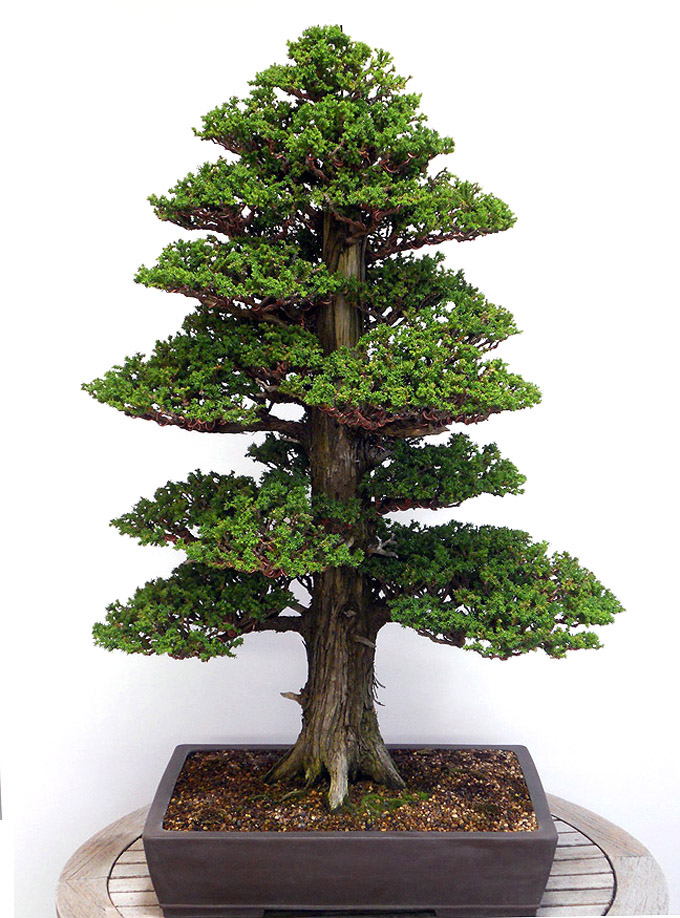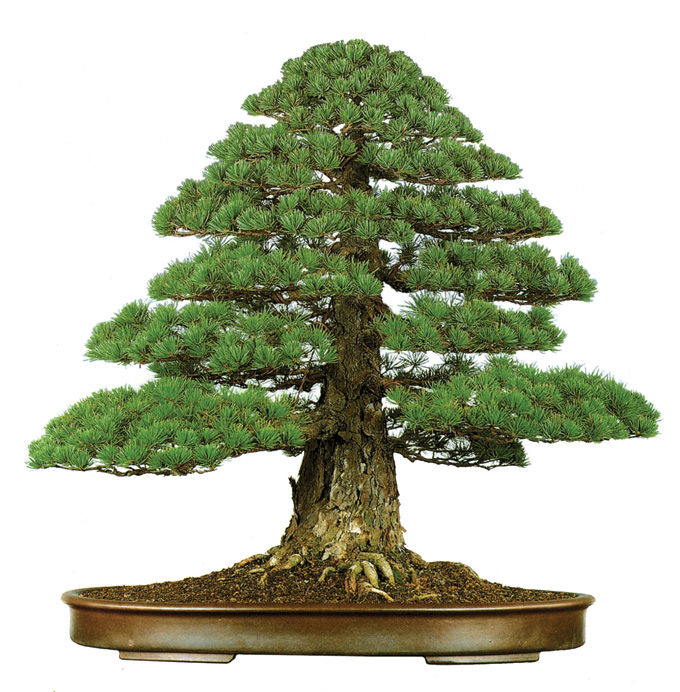 This Cryptomeria japonica is reminisent of the unimaginably vast and towering Giant sequoias in California’s Sierra Nevadas. This effect could be enhanced by photographing it from a little lower (see the photo below), but you still get the drift.
This Cryptomeria japonica is reminisent of the unimaginably vast and towering Giant sequoias in California’s Sierra Nevadas. This effect could be enhanced by photographing it from a little lower (see the photo below), but you still get the drift.
Far and few between
What a great tree. It’s from Michael Hagedorn’s Crataegus Bonsai. You seldom see a real good formal upright bonsai (you don’t see very many formal uprights at all) and you don’t see many good Cryptomeria bonsai either. Especially in the West; they are more common in Japan (their common name in English is Japanese cedar, even though they’re not really cedars; they are from Japan however).
In Michael’s own words
“This cryptomeria was one of the standout trees in Boon’s backyard when I studied with him ten years ago. He’s been maintaining it for years. It was originally styled by Mitsuya during one of his visits to the states in the early ’90?s, and is the most significant cryptomeria I’ve seen in the United States. It’s about a meter tall, and has been developing as a bonsai for about twenty years….” For the whole story, visit Crataegus Bonsai.
 Another dignified formal upright. The one is a legendary Japanese white pine (perhaps the most famous formal upright bonsai in the world). If was restyled by Masahiko Kimura (The Magician) just before this photo was taken in 1997. It appears in our book: Pines, Growing and Styling Japanese Black and White Pines, which is recently back in print and is available at Stone Lantern.
Another dignified formal upright. The one is a legendary Japanese white pine (perhaps the most famous formal upright bonsai in the world). If was restyled by Masahiko Kimura (The Magician) just before this photo was taken in 1997. It appears in our book: Pines, Growing and Styling Japanese Black and White Pines, which is recently back in print and is available at Stone Lantern.
Wayne- I have contacted you once or twice briefly in the past. Today, after looking at the picture of the Cryptomeria and especially the White Pine, I have a couple of questions for you, and hope you have a moment to answer.
1. I am retired on a small, fixed income that just barely allows me to work on threes at all. I have not pre-ordered the Pines book. I also live in a remote area in which there are no other people practicing this art. The question has two parts: 1a. as the climate zone here is Canadian zone 4, +/-, and there is wind especially bad in a winter that goes at least from late November to March, reaching a low of -25C and below freezing for most of that time, what kind of pine can I grow successfully? 1b. what pines can I work on which have the possibility of forming formal upright?
2. Likewise two parts: 2a. Why are spruce trees – white, black, etc. – not spoken of as trees for bonsai? They are much easier for me to find locally – by the millions. And, 2b. why are there few or no mention of fir trees used in bonsai? Also available by the millions.
Thanks in advance,
Fred Elford
Hi Fred,
A lot to chew on here.
Zone 4 with wind is pretty tough. Good snow cover and/or heavy mulch helps. You can also wrap your trees. I think mugo pines will do well in your climate, but they really aren’t suitable as formal upright. There are some other zone four pines. The rocky mountain variety of Ponderosa might do well in your climate and are better suited to formal upright. Bristlecone do well here in northern Vermont (zone 4 also) but we don’t have that much wind and usually have pretty good snow cover. Lodgepole is another good one and it grows way north into Yukon.
Spruce are tricky. Most of the natives (white, black and reds here in VT) have shoots that are on the long side for bonsai, though there are naturally dwarfed ones that can work. Another potential problem is that (most?) spruce don’t shape well with wire; they tend to bounce back to their original form.
One native spruce that can make a decent bonsai is the Alberta. As far as non natives go, some Norway spruce culitvars make pretty good bonsai. There’s also the Ezo from Japan, which is excellent.
You are right about firs, you don’t see many fir bonsai. Our native fir here is the Balsam. I’m field growing some so we’ll see in a few years. The needles seem small enough and they are tough trees, so perhaps they’ll work. We’ll see.
I’ve got some dwarfish native spruce (mostly white) that I’ve collected around here and have been field growing. Dug up a few this season and did some work and then put them back in the ground. Some look a little promising, but only time will tell.
Fred. Almost forgot. Think Larch. They make great bonsai and are easy to grow cold climate trees.
Hi Fred,
Out of curiosity, where are you located? I’m in Hamilton, Ontario, but I grew up in the Ottawa area, and have family roots in northern Ontario, so I’m familiar with the climatic challenges you describe. Spruce are indeed on the elastic side, but they are workable. I’m currently working on a nest spruce, which has very short needles…almost (but not quite) as small as Ezo spruce. As for pines, I’ve got an Austrian pine (Pinus nigra) which is OK here and might work for you. There are native species, like Jack pine, too, which you might want to try. I think Jack pine is starting to get more attention from local bonsai clubs. It seems very similar in appearance to Scots pine. They grow in very dry, exposed environments, often just clinging to rock. I always remember seeing them on trips up north to visit my relatives. If you’re looking for classic bonsai material, Japanese black pine are always a choice. I’m growing some from seed, so hopefully within the next 5 years or so I’ve have some nice little shohin trees going. The seed option would be affordable, and if you’re looking to create a formal upright, it would give you a lot of control over the growth.
Winter wind is always a problem with any of my trees, but they seem fine with suitable protection. If you live in a house with a garden, you can always just bury the trees up to the ege of the pots and then cover everything with a tarp, or try overwintering them in a shed/garage. I pack snow on the surface of the pots of the trees in the shed…that way, if we have a milder day, it just melts and keeps the trees from drying out.
I haven’t tried any fir trees myself, but I am curious about them. You’re right – one doesn’t often see them…I just did a Google search, though, and found some images that might be a good source of inspiration. I might pick up some balsam fir to give it a try.
Good luck, and just think…even without a local bonsai club, we now have access to experience from around the world – something that wasn’t really possible 30 years ago! It’s probably possible to practise bonsai almost anywhere…except perhaps above the tree-line and even then probably somebody out there is doing it! :-)
If you are interested in Spruce and Fir bonsai material you may want to try
a Christmas tree farm.
I found some old Frasier fir and White spruce tree stumps that had sprouted in a local CT farm that would make excellent bonsai.
I live in Zone 4a, Wisconsin.